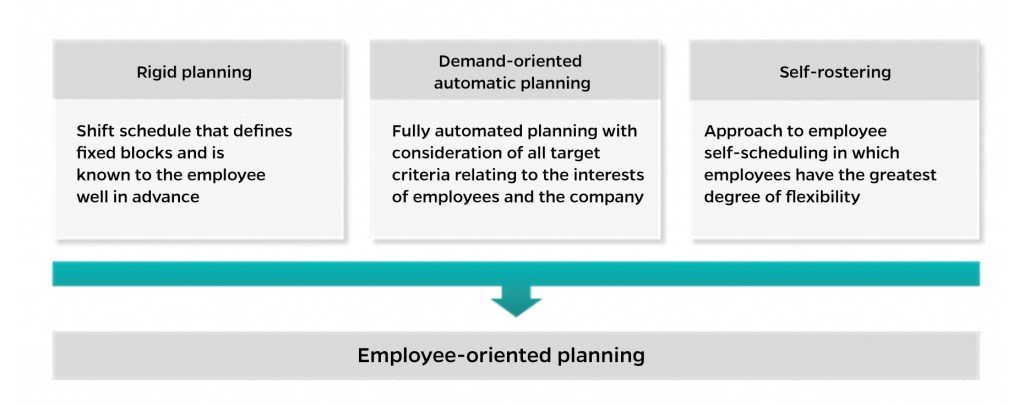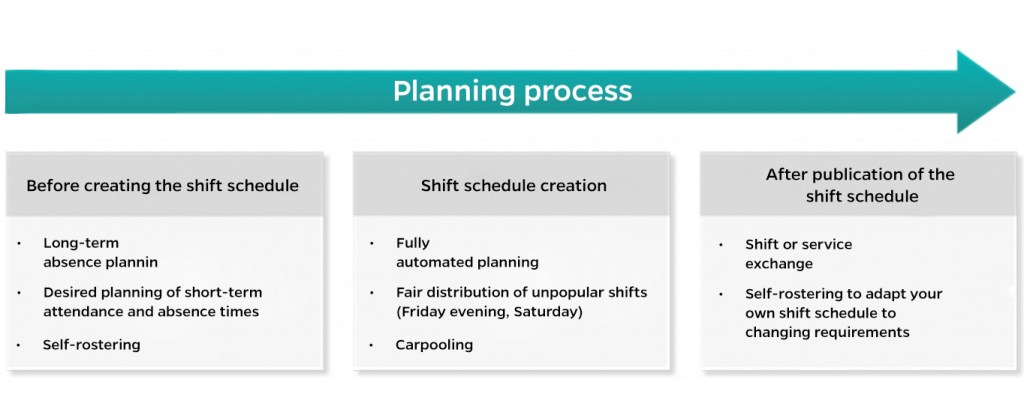Flexible Shift Scheduling: 3 Reasons for Higher Employee Satisfaction

As working hours have become increasingly flexible (various contractual hours, dynamic changes from full-time to part-time and back again, lifetime working time accounts), a change has also taken place in the area of shift scheduling in recent years.
Content
↓ What is the aim of flexible shift scheduling?
↓ How does employee-oriented shift scheduling combine business requirements and satisfied employees?
↓ How does self-rostering work in employee shift scheduling?
What is the aim of flexible shift scheduling?
In principle, we see two different approaches to planning in companies. On the one hand, demand-oriented automatic planning (e.g. in call centers), where a central planner independently creates a shift schedule with the help of planning algorithms and the employees receive the schedule to execute their work according to the schedule. On the other hand, there is the typical blank shift schedule printed out in the recreation room (e.g. in the healthcare sector), which each employee can enter themselves. However, once the plan has been finalized and approved by the planner, it is usually fixed in both cases.
The aim of making planning more flexible is, on the one hand, to better meet the company’s requirements and, on the other, to enable employees to design their schedules more individually so that they can better organize their private and professional lives according to their wishes. By achieving a higher level of satisfaction, employees can be better retained by the company, especially in today’s “war for talent”.
How does employee-oriented shift scheduling combine business requirements and satisfied employees?
Employee-oriented planning with plano WFM places employees at the center of planning and challenges how the above-mentioned goals can be pursued and what measures can be used to achieve employee satisfaction regarding shift scheduling.

Satisfaction can only be achieved if the shift schedule is no longer created by simply assigning it to the employees, but with the help and full participation of the employees in creating the schedule.
Already for Generation Y, flexible working hours and the consideration for the work-life balance are of enormous importance. Free time (planning) and the freedom to organize their working hours are very important for employees born between 1979 and 1998. Generation Z, which followed from 1999 onwards, is continuing along this path, but as “digital natives” expect greater support from digital technologies. Companies must meet these requirements and provide appropriate tools for participation in shift scheduling.
Companies that have so far only implemented the vacation planning process digitally need to follow suit as quickly as possible to increase and permanently ensure the satisfaction of the new generations of employees. Employees should always have the opportunity to participate in the scheduling process. This includes not only the time when the planner actually creates the schedule, but also the period before the schedule is created and the period after the schedule has been published.
In addition to long-term annual leave planning, employees can be involved even before the shift schedule is created by making their individual attendance and absence requests known via an employee portal. Part-time employees, e.g. students, must be able to flexibly enter their availability so that a shift schedule can be created around existing activities.
You can find more information about our employee portal myplano and ESS at:
https://plano-wfm.com/en/myplano-employee-self-service-ess/
3 reasons for higher employee satisfaction
- Improved work-life balance
Flexible shift scheduling allows employees to better adapt their working hours to their personal needs and family commitments. This leads to a better work-life balance, as employees can coordinate their free time and work commitments more effectively. Such a balance contributes significantly to the overall satisfaction and well-being of employees.
- Greater degree of autonomy and co-determination
Involving employees in the scheduling process gives them a higher degree of autonomy and co-determination. Employees who have an influence on their working hours feel more valued and respected. This participation increases motivation and commitment, as employees have the feeling that they are actively involved in shaping their working environment.
- Use of modern software
The implementation of modern, digital tools in shift scheduling ensures that working hours are organized smoothly and transparently. Such tools minimize misunderstandings and facilitate communication between employees and the administration. Clear and efficient planning leads to better collaboration and reduces stress, which ultimately increases employee satisfaction.
How does self-rostering work in employee scheduling?
Demand-oriented automatic planning
While many companies still use a purely manual, multi-round process, some companies already use a mix of manual self-scheduling and subsequent automated shift scheduling. In such a scenario, employees schedule themselves for availability services offered, which have a slightly larger time frame (approx. 2-3 hours). The employee can decide whether they prefer to work earlier or later and can thus organize their social life accordingly. The actual working hours are specified when the planner creates the actual shift schedule. Here, the planner still has a very high degree of freedom for the company in terms of covering demand and can respond very dynamically to short-term changes.
We see self-rostering as the freest approach to shift scheduling for employees. Self-rostering is a trend that has been practised for years in our neighboring countries Belgium and the Netherlands and is now increasingly attracting the attention of companies in Germany. When implementing pure self-rostering, employees schedule themselves completely independently. They have a full overview of their time sheet at all times and must plan their target hours within the specified framework. The system ensures that employees with a weekly working time of 35 hours schedule themselves between 32 and 38 hours. Alternatively, the team leader/planner would schedule the remaining hours in the event of open times. The system also ensures that all legal regulations and company agreements are adhered to.
In addition to covering demand and complying with legal or company rules, employee interests are increasingly being taken into account in this algorithm-driven scheduling process. For example, fairness criteria ensure that unpopular shifts or times are distributed evenly across all employees. Employee-specific priorities can be used to control which activities or workstations an employee is scheduled for. Requirements for equal working hours are also taken into account in automatic planning. This is the case, for example, if employees have organized themselves into carpools.

After the final creation and publication of the shift schedule by the planner, employees may still wish to change their working hours. In this case, employees in the employee portal have the option of contacting colleagues to swap shifts. The search for suitable shifts is made possible by contacting colleagues directly or via a notice board.
Conclusion:
Engaging employees more closely – with digital workforce management
Today and in the future, employee satisfaction will be achieved less through table football in the lounge and more through the free organization of working hours and free time. In order to harmonize the requirements of employees with the needs of the company, these processes need to be digitally mapped with ever greater employee involvement. With plano WFM, we support our customers in successfully implementing this as part of a digitalization strategy for their workforce management.
Written by: René Birnstiel, Product Manager

Would you like to find out more?
Further information about our workforce management software and the areas of application can be found here:
→ Workforce management from plano
Archive
Employee Retention in Retail
We’re Here for You
